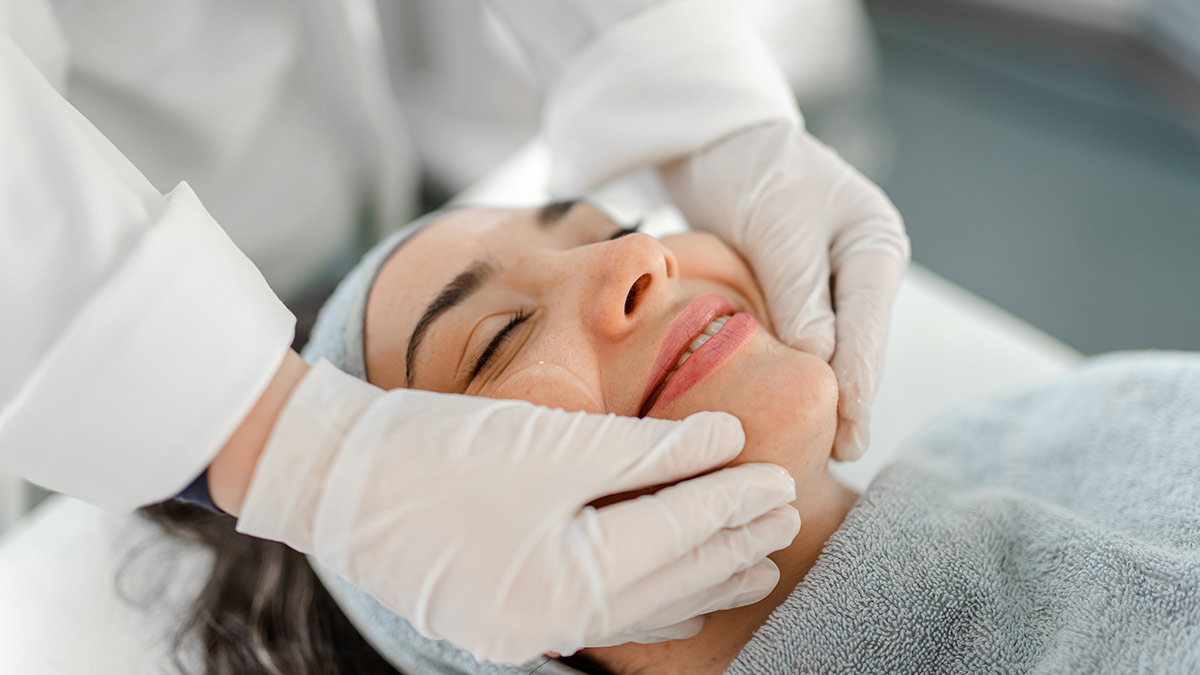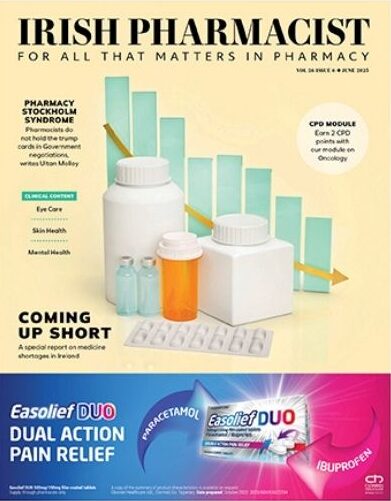EAMONN BRADY MPSI PRESENTS A CLINICAL EVALUATION OF THE DIFFERENT FORMS OF PSORIASIS, AS WELL AS TRIGGERS, TREATMENTS AND THERAPEUTIC MEDICATIONS
There are several different types of psoriasis. Typically, people have only one form of psoriasis at a time, although sometimes two different types can occur together. One type may change to another type, or one type may become more severe. Psoriasis often goes through cycles. It can flare-up for a few weeks or months, and then the symptoms can ease or stop.
Common types of psoriasis are:
Plaque psoriasis: The most common form of psoriasis. Around 80 per cent of psoriasis cases are plaque psoriasis. Symptoms are dry, red skin lesions, known as plaques, that are covered in silver scales. They normally appear on elbows, knees, scalp and lower back, but can appear anywhere on the body. The plaques are normally itchy, sore, or both. In severe cases, the skin around joints may crack and bleed.
Guttate psoriasis: This normally occurs following a throat infection (streptococci) and is more common among children and teenagers. This causes small (less than 1cm) water-drop shaped sores on the chest, arms, legs and scalp. There is a good chance that guttate psoriasis will disappear completely, but some young people go on to develop plaque psoriasis.
Scalp psoriasis: This normally affects the back of the head, but it can occur in other parts of scalp, or on the whole scalp. This causes red patches of skin covered in thick silvery-white scales. Some people find scalp psoriasis extremely itchy, while others have no discomfort. In extreme cases it can cause hair loss, but not permanent balding.
Inverse psoriasis: this affects areas of the skin that are in folds or creases, such as the armpits, groin, and the skin between the buttocks and under the breasts. This can cause large, smooth red patches to occur in some or all of these areas. Inverse psoriasis is made worse by friction and sweating, so it can be particularly uncomfortable in hot weather. Inverse psoriasis is more common in obese patients.
Pustular psoriasis, Von Zumbusch psoriasis: This causes pustules to appear across a wide area of skin. The pustules develop very quickly. The pus consists of white blood cells and is not infected. The pustules dry and peel off within a couple of days, leaving the skin shiny and smooth. The pustules may reappear every few days or weeks in cycles. During the start of these cycles, Von Zumbusch psoriasis can cause fever, chills, weight loss and fatigue.
Palmoplantar pustular psoriasis: This causes pustules to appear on the palms of hands and the soles of feet. Pustules may reappear every few days or weeks.? Acropustulosis: This causes pustules to appear on fingers and toes. The pustules then burst, leaving bright-red areas that may ooze or become scaly. These may lead to painful nail deformities.
Erythrodermic psoriasis: The rarest form of psoriasis. This can cover the body with a widespread red rash that causes intense itching or burning.
Erythrodermic psoriasis: Can cause loss of proteins and fluid. This can lead to dehydration, heart failure, hypothermia and malnutrition.
Psoriasis is an autoimmune disease and its exact cause is unknown. The autoimmune response results in a cycle of skin cell production becoming faster and faster. Skin cells are created and then die in the space of five-to-six days, rather than the normal 28 days. The dead skin cells then build on the surface of the skin in thick, scaly patches. Psoriasis runs in families. One-in-three people with psoriasis have a close relative who also has psoriasis. However, the exact role that genetics plays in causing psoriasis remains unclear.
Psoriasis triggers
Many with psoriasis find that symptoms start or become worse because of a certain trigger. Identifying a trigger may allow avoidance of a flare-up. Common triggers include:
- Alcohol.
- Smoking.
- An injury to the skin such as a cut, scrape, insect bite, or sunburn (this is known as ‘the Koebner response’).
- Stress.
- Certain medicines like lithium, antimalarial medicines, NSAIDs, and ACE inhibitors and beta blockers.
Treatment
Appropriate treatment will keep psoriasis under control but there is no out-and-out cure. Treatment depends on the type and severity of psoriasis and the area of the skin affected.
Topical psoriasis treatments
Topical corticosteroids: These are the most common treatment for mild-to-moderate psoriasis. They work by slowing the production of skin cells. Topical corticosteroids range in strength from mild (hydrocortisone), to very potent (clobetasol). Over-use can lead to developing a tolerance and skin atrophy.
Vitamin D analogues: The vitamin D analogues suppress the production of skin cells. The most widely used vitamin D analogue is calcipotriol (Dovonex), which is used to treat mild-to-moderate psoriasis. Calcipotriol generally has few side-effects if used correctly. Dovonex now have an OTC version pharmacists can recommend to those previously diagnosed with psoriasis following a specific protocol.
Dithranol: This has been used for over 50 years in the treatment of plaque psoriasis. It is effective in suppressing the production of skin cells and has no side-effects. However, it is typically only used as a short-term treatment under hospital supervision, as it stains everything it comes into contact with, including skin. It is normally only applied to skin for five minutes before being washed off to reduce the risk of skin staining. Dithranol is often used in combination with phototherapy.
Tazarotene: This cream contains a retinoid that slows the production of skin cells. It is used in the treatment of moderate plaque psoriasis. The most common side-effect is skin irritation. Tazarotene can cause birth defects, so it should be strictly avoided during pregnancy or if breastfeeding. It is not recommended for children or teenagers.
Coal tar: A thick, heavy oil that is probably the oldest treatment for psoriasis. How it works is not exactly known, but it reduces scaling, inflammation and itchiness. Coal tar can stain clothes and has a very strong smell. It is often used in combination with phototherapy.
Phototherapy
Phototherapy uses natural and artificial light to treat psoriasis.
Sunlight: Brief, daily exposure to small amounts of sunlight can improve symptoms, but too much sun can cause a worsening of the condition and cause skin damage.
UVB phototherapy: This uses ultraviolet B light that is invisible to human eyes. The light slows down the production of skin cells and is an effective treatment against guttate or plaque psoriasis that has not responded to a topical procedure. Treatment takes place at a hospital under the supervision of a dermatologist. Ten-to-30 sessions are normally needed.
Tazarotene can cause birth defects, so it should be strictly avoided during pregnancy or if breastfeeding
Psoralen plus ultraviolet A (PUVA): This treatment may be used for severe psoriasis that has not responded to other treatment. Common side-effects of the treatment include nausea, headaches, burning and itchiness.
Combination light therapy: Combining phototherapy with other treatments often increases the effectiveness of phototherapy. Some specialists use UVB phototherapy in combination with coal tar, as the coal tar makes the skin more receptive to light. Combining UVB phototherapy with Dithranol cream has also proved effective.
Oral and systemic medication
Oral or systemic treatments are reserved for when psoriasis is severe and is resistant to other treatments. Oral medications can be very effective in treating psoriasis, but they all have potentially seriously side-effects, hence they are only used for short periods of time.
Methotrexate: Methotrexate decreases the production of skin cells and suppresses inflammation. It is useful in treating pustular psoriasis, psoriatic erythroderma and extensive plaque psoriasis. It has no short-term side-effects, but long-term use can cause serious liver damage. It is contraindicated with liver disease. Alcohol should be avoided. Women should take adequate contraceptive precautions to avoid falling pregnant during therapy and for three months afterwards. Methotrexate can affect how sperm cells develop, so men should avoid fathering a child during therapy and for three weeks afterwards.
Acitretin: Acitretin is an oral retinoid that reduces the production of skin cells. It is used to treat severe psoriasis that has not responded to other treatments. It has a wide range of side-effects, including dryness and cracking of the lips, dryness of the nasal passages, loss of hair, and in rarer cases, hepatitis. Acitretin causes serious birth defects, and women should avoid pregnancy during treatment, and for two years after.
Ciclosporin: Ciclosporin is an immunosuppressant. It has proved effective in the treatment of all types of psoriasis, but should be limited to severe psoriasis only due to its potential adverse reactions.
Written by Eamonn Brady (MPharm) who graduated from the School of Pharmacy, Robert University, Aberdeen, in 2000 and owns two Whelehans pharmacies in Mullingar.
WASHING, MOISTURISING AND EMOLLIENT THERAPY
Keeping the skin well moisturised is key to managing the condition.
Emollient therapy
Always use soap substitutes for washing your skin all times, ie, Silcocks base, aqueous cream, emulsifying ointment or any brand name soap substitute, such as Aveeno.
Do not let soap, shower gel, bath foam or shampoo contact your skin.
Avoid perfumed products — spray on clothes if necessary.
If possible, wash hair over the bath or sink.
Drying
Pat the skin dry gently. Avoid scrubbing skin with a towel.
How and how often to use moisturisers
Moisturise the skin immediately after washing while it is still damp; it is more effective when applied at this stage. The more often you moisturise your skin, the more effective moisturisers are. There is no limit to the number of times that you can apply a moisturiser. Always apply moisturisers in a downward motion, in the direction of hair growth. Gently massage it into the skin. Apply enough to moisten the skin without leaving it greasy. To help you remember to apply it, keep samples in various locations at home, at work and in your bag or pocket.
Choose one that you like and feels comfortable. Always avoid perfumed products.
Emulsifying ointment
Run a lukewarm water bath. Put two tablespoons of emulsifying ointment in a jug of almost-boiling water. Whisk into cream froth and add to bath water. Emulsifying ointment makes the bath slippery, so caution is needed when getting in and out of the bath. Emulsifying ointment can be kept soft by storing it in the hot press. Stay no longer than 10 minutes in the bath. Pat skin dry afterwards and if prescribed steroidal skin cream, apply to affected area then wait 10-to-15 minutes and apply moisturiser in a downward motion.







